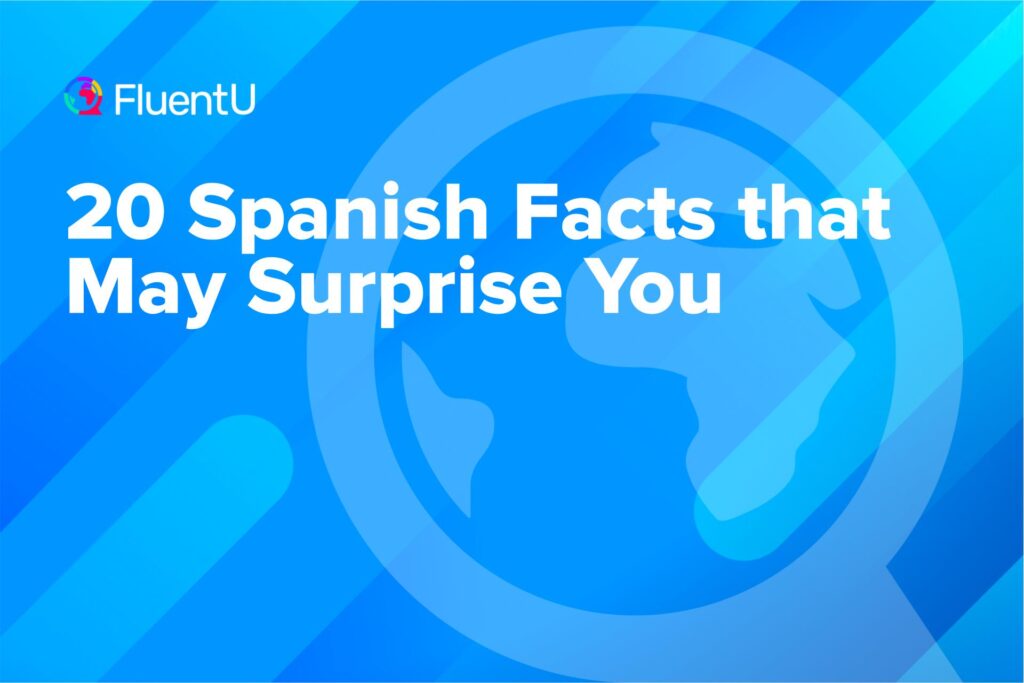Contents
- 1. Over 400 million people speak Spanish
- 2. 21 countries have Spanish as an official language
- 3. It’s a Romance language
- 4. The language has Latin origins
- 5. It has two names: Castellano and Español
- 6. Spanish is a phonetic language
- 7. The Royal Spanish Academy is in charge of the language
- 8. There are many regional varieties of Spanish
- 9. Arabic heavily influenced Spanish
- 10. The earliest Spanish texts are over 1000 years old
- 11. It’s poetic and has long sentences
- 12. Demand for learning Spanish is increasing
- 13. Spanish has formal and informal forms
- 14. The longest word in the language is 23 letters
- 15. Saying “library” is a popular tongue-twister
- 16. Spanish uses inverted punctuation
- 17. The first modern novel was written in Spanish
- 18. It’s given many loanwords to English
- 19. Spanish uses cute diminutives
- 20. Mexico has the most Spanish speakers
20 Spanish Facts that May Surprise You

You may think you know everything there is to know about the Spanish language—after all, Spanish is all around us.
You also may know that Spanish is a language that’s on the rise.
It’s spoken in many diverse areas of the world, so speaking Spanish gives you a superpower: to be able to communicate with hundreds of millions of people.
However, despite its ubiquity, you might still be surprised by some cool details about the Spanish language.
Here are 20 interesting facts about the Spanish language that will surprise you, I’m sure.
Download: This blog post is available as a convenient and portable PDF that you can take anywhere. Click here to get a copy. (Download)
1. Over 400 million people speak Spanish
Spanish is the mother tongue of an estimated 400 million people, making it the world’s second most spoken language.
Spanish only falls in second place behind Chinese, which is spoken by about a billion people and far outranks any other language.
Spanish surpasses English in its number of speakers, as English comes in third place with 375 million native speakers around the world.
2. 21 countries have Spanish as an official language
Spanish is official in 21 countries across Europe, Africa, Central, South and the Americas, so it’s a true global heavyweight. It’s the primary language in Latin America. For many, it’s the only way to communicate, used in official documents and schools. While English is spoken in 112 countries, French in 60, and Arabic in 57, Spanish takes fourth place—still a big deal.
Notably, international organizations like the United Nations use Spanish officially, underscoring its worldwide significance.
3. It’s a Romance language
Spanish is part of the Indo-European language family, including French, English, and others across Europe, South Asia, and beyond. The term “Indo-European” marks its range from India to Europe.
Spanish is a Romance language, like Catalan, Italian, French and more. The intercontinental connections make Spanish stand out. Understanding its roots and ties to other languages gives a richer grasp, helping you connect with Spanish on linguistic, historical, and cultural levels.
4. The language has Latin origins
Spanish evolved from a specific spoken Vulgar Latin, developing in the north-central Iberian Peninsula after the Western Roman Empire’s fall in the 5th century. Spanish emerged in Iberia and carries strong Latin roots—around 75% of words link to Latin.
Toledo and Madrid set written standards from the 13th to 16th centuries. Over a millennium, this form of Spanish spread from the Mediterranean southward, embraced by the Spanish Empire and colonies in the Americas.
5. It has two names: Castellano and Español
Spanish speakers often refer to their language as español as well as castellano, which is the Spanish word for “Castilian.”
The terms applied can differ from region to region, and they can also reflect political and social views. In English, the term “Castilian Spanish” can be used to refer to individual dialects of Spanish spoken in the northern and central parts of Spain. Occasionally, the term is used more loosely to refer to the Spanish spoken in Spain, as opposed to Latin American Spanish.
6. Spanish is a phonetic language
People often know Spanish words like “tapas” and “siesta.” Some English words, like “jeans” and “hotel,” show that Spanish has also borrowed a few words from English.
Yet, Spanish and English have at least one big difference. Spanish is phonetic, so letters make predictable sounds. This means that you pronounce letters consistently and each letter represents a certain sound.
It’s beginner-friendly, especially for spelling and talking. Sounds and letters match up, usually no spelling surprises. But don’t relax just yet.
7. The Royal Spanish Academy is in charge of the language
The Royal Spanish Academy guards the Spanish language and operates from Madrid, overseeing language academies in 21 Spanish-speaking countries. Founded in the 18th century, it crafts dictionaries and grammar guides adopted globally.
Innovating, it introduced the inverted question and exclamation marks and added the ñ to the alphabet in the 18th century—a standout in the Spanish language’s rich journey.
8. There are many regional varieties of Spanish
Spanish grew out of Latin and expanded through colonization from the Iberian Peninsula to Latin America. It’s intriguing how Spanish differs between Spain and Latin America, and even within Latin America.
Yet, don’t sweat the small stuff like vocabulary tweaks or grammar quirks—it’s still easy to chat. Using “neutral” Spanish on your travels makes communicating a breeze, because everyone understands it.
The different variations came from colonies evolving separately, before modern connections. Time brought out local lingo, accents and unique language twists. Take “vos” in Paraguay, Uruguay, and Argentina—it’s got its own cool twist. These flavors of Spanish show just how diverse it is!
9. Arabic heavily influenced Spanish
Back in 711, Arab armies brought art, architecture and language to Spain. Arabic mixed with old Spanish to shape today’s language. When Spain bid bye to Arabs in 1492, they left 8,000 words behind.
Arabic’s next to Latin as Spanish’s big influencer. Words you know like “el alfombra” (carpet), “la almendra” (almond) and “la almohada” (pillow) have Arabic roots. While traveling around Spain, you’ll find Arabic in place names, too, like La Alhambra. And the Spanish “ojalá“? It’s from Arabic, starting as “law sha Allah,” turning into hope.
10. The earliest Spanish texts are over 1000 years old
Back in 964, we had the Las Glosas Emilianenses, some notes in Spanish and Basque on a religious Latin text, considered the earliest Spanish writing. They’re like ancient post-its.
Likely a monk from Suso Monastery wrote them.
But surprise! In 2010, the Royal Academy of Spanish said the 9th century “Cartularies of Valpuesta” from Burgos Province hold the first written Spanish. History’s a bit sneaky like that.
11. It’s poetic and has long sentences
When you go from English to Spanish, expect about 15-25% more text. It’s not that Spanish words are longer—it’s because Spanish loves to dive deep and get all poetic.
It takes more words to paint a picture that English sums up in one. Like “en el sentido de las agujas del reloj” means “clockwise,” but Spanish goes for detail over a single word. It’s why Spanish texts grow, showing its expressive side.
12. Demand for learning Spanish is increasing
Spain’s been a hit for travel and studying abroad. Learning Spanish in schools and colleges is on the rise. Now, even Asia’s catching on, showing its global economic value.
Online, Spanish spiked 800%, making it the internet’s third most used language, just behind Mandarin and English. About 18 million students are into Spanish, and experts predict a 10% global Spanish-speaking crowd in a few gens, up from today’s 6%. That’s some serious growth!
13. Spanish has formal and informal forms
In Spanish, knowing when to be casual or formal is a big deal. We’ve got “tú” and “vosotros” (in Spain) for hanging out, and “usted” and “ustedes” for being polite.
It’s all about showing respect. When you mean business or talk to new people, being formal is the way. But with pals and family, being chill with the informal stuff works. Getting this balance right is like a secret handshake for good Spanish conversations.
14. The longest word in the language is 23 letters
The longest word in Spanish is “esternocleidomastoideo,” which is a muscle in the neck. It’s a mouthful with 23 letters, showing how Spanish can really go the distance with these big words.
It’s like a window into how the language likes to pack in details. These kinds of twists highlight how Spanish can squeeze a lot of meaning into a single word.
Here’s how to pronounce this word:
15. Saying “library” is a popular tongue-twister
La biblioteca is like a cheeky tongue twister in Spanish that gives your mouth a workout with those tricky “b” and “l” sounds back-to-back. Saying it over and over is like a mini diction challenge, showing off how interesting Spanish can be.
It’s a cool way to practice speaking clearly and nailing those sounds, and people often use it as a fun exercise.
16. Spanish uses inverted punctuation
In Spanish, we use inverted punctuation marks like ¿ (upside-down question mark) and ¡ (upside-down exclamation mark) to kick off questions and exclamations.
These special marks set the tone right at the beginning, giving readers a heads-up on what’s coming next. They’re like little hints that make understanding easier.
This cool feature isn’t just for show—it boosts how clear and understandable written Spanish is. It shows how the language values making things crystal clear and letting those shades of meaning shine through.
17. The first modern novel was written in Spanish
Miguel de Cervantes, a pivotal figure in Spanish and world literature, holds the notable legacy as the author of “Don Quixote,” often regarded as the first modern novel.
Published in 1605, this work started the modern novel form. It follows the adventures of Don Quixote, skillfully intertwining complex characters and magical realism elements. This masterpiece’s impact on literature and enduring popularity firmly establish its significance, marking a crucial transition from medieval romance to the dawn of modern fiction.
18. It’s given many loanwords to English
Spanish loanwords have truly enriched English, highlighting their historical and cultural ties.
From “taco” to “patio,” these borrowings span cuisine to architecture. Music’s “salsa” and “rumba” and social terms like “amigo” and “fiesta” also show Spanish’s impact.
These words reflect connections between Spanish and English communities, weaving a diverse linguistic and multicultural fabric in English.
19. Spanish uses cute diminutives
In Spanish, adding suffixes like “-ito” or “-ita” to words infuses emotion. For instance, “casa” (house) becomes “casita” (cozy little house), conveying warmth.
Diminutives also soften conversations, making interactions friendlier. They’re common in Hispanic cultures, creating closeness—like “abuelita” (grandma) or “perrito” (puppy). This enriches communication, reflecting cultural and emotional ties in the Spanish-speaking world.
20. Mexico has the most Spanish speakers
Mexico is home to over 120 million Spanish speakers, making it the world’s largest population of such speakers. While Spanish gained dominance from colonial times, Mexico retains linguistic diversity with regional accents and indigenous languages.
The official language is Spanish, but the country also values its indigenous languages through bilingual education. This blend shapes Mexican identity, seen in literature by Octavio Paz and music like mariachi. Festivals like Día de los Muertos showcase the mix of indigenous and Spanish traditions.
Interesting fact: Spain is just fourth on the list of largest numbers of Spanish speakers in a country.
These fascinating facts about the Spanish language reveal the language’s long heritage as well as its importance and growth in the world today.
Hopefully this will be a good incentive to people of all ages and from all kinds of backgrounds to learn Spanish, and to enjoy the many benefits that speaking Spanish can bring!
Download: This blog post is available as a convenient and portable PDF that you can take anywhere. Click here to get a copy. (Download)







